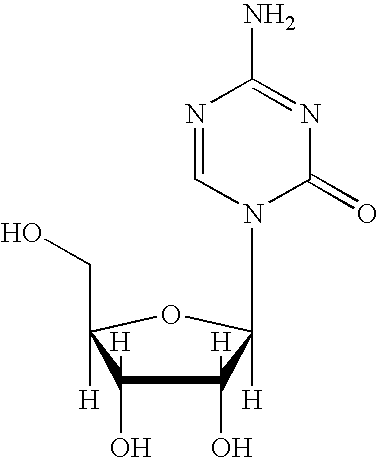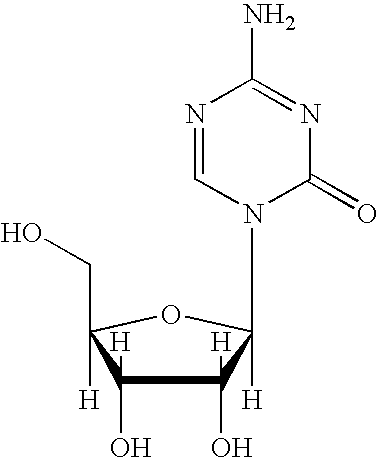Synthesis of 5-azacytidine
a technology of azacytidine and azacytidine, which is applied in the field of synthesis of 5azacytidine, can solve the problems of difficult scaling up, requirement of a deprotection step, and inacceptable synthesis of an active pharmaceutical ingredient (api) for human use, and achieve the effect of avoiding the hydrolysis of the s-triazine ring and being easy to scale up
- Summary
- Abstract
- Description
- Claims
- Application Information
AI Technical Summary
Benefits of technology
Problems solved by technology
Method used
Image
Examples
example 1
Preparation of Silylated 5-Azacytosine
[0051]
[0052]In a 22 L, 3-necked flask, a mixture of 5-azacytosine (1) (2.0 kg, 17.8 mol, 1.07 molar eq.), HMDS (9.162 kg) and ammonium sulfate (40.0 g) was heated at reflux for 2 hours. A fresh amount of ammonium sulfate (20.0 g) was added, and the reflux was continued for 6 hours longer. The initial slurry turned into a clear, pale-yellow, solution and no more gas evolved at the end of the reflux. The excess HMDS was evaporated off in vacuum to obtain an off-white residue, which is trimethylsilylated 5-azacytosine (6).
example 2
Coupling of Silylated 5-Azacytosine to Sugar
[0053]
[0054]Trimethylsilylated 5-azacytosine (6) prepared according to the method of Example 1 was diluted with anhydrous dichloromethane (18.1 kg) in a 50 L, 3-necked, flask and solid, 1,2,3,5-Tetra-O-acetyl-β-D-ribofuranose (5.330 kg, 16.7 mol) (7) was charged to the mixture. An anhydrous dichloromethane rinse (0.533 kg) was used and the slurry was cooled to 0–5° C. TMS-triflate (4.75 kg, 1.2 molar eq.) was added to the mixture over 5–10 minutes. During the addition, the reaction temperature increased to 15–20° C., and the initial suspension turned into a clear, pale-yellow, solution. After 2 hours of stirring, the solution Was poured over a mixture of Na2CO3 (2.00 kg), NaHCO3 (2.00 kg), water (29.9 kg) and ice (20.0 kg). The layers were separated. The water layer was extracted with dichloromethane (8.0 kg). The combined organics were washed with cold (0–5° C.) 10% NaHCO3 (2×10 L). The combined washings were extracted with dichloromethan...
example 3
Deprotection of Protected 5-azacytidine
[0055]
[0056]Protected 5-azacytidine (8) from Example 2 was diluted with methanol (35.5 kg), then 25% NaOMe in methanol (439 g, 0.11 mol. eq.) was charged. The initial clear solution became turbid and a solid started to precipitate. The slurry was left under nitrogen overnight. The solids were isolated and washed with methanol (7×2.4 kg). The solids were dried (˜28 inHg and ˜85° C.) to a constant weight to give crude 5-azacytidine (1.835 kg; 44.9%) (5).
PUM
| Property | Measurement | Unit |
|---|---|---|
| temperature | aaaaa | aaaaa |
| pH | aaaaa | aaaaa |
| temperature | aaaaa | aaaaa |
Abstract
Description
Claims
Application Information
 Login to View More
Login to View More - R&D
- Intellectual Property
- Life Sciences
- Materials
- Tech Scout
- Unparalleled Data Quality
- Higher Quality Content
- 60% Fewer Hallucinations
Browse by: Latest US Patents, China's latest patents, Technical Efficacy Thesaurus, Application Domain, Technology Topic, Popular Technical Reports.
© 2025 PatSnap. All rights reserved.Legal|Privacy policy|Modern Slavery Act Transparency Statement|Sitemap|About US| Contact US: help@patsnap.com



